Peregrine falcons are both messy and picky eaters. I photographed this one in late December of 2011 as it worked over a duck carcass along the Antelope Island causeway. On this frigid morning the lighting conditions were abysmal so I had very little shutter speed to work with. I did my best to time my shots when the bird wasn’t moving much (with mixed success) and at f/5.6 I had minimal depth of field so most of the shots I saved had the bird broadside to me.
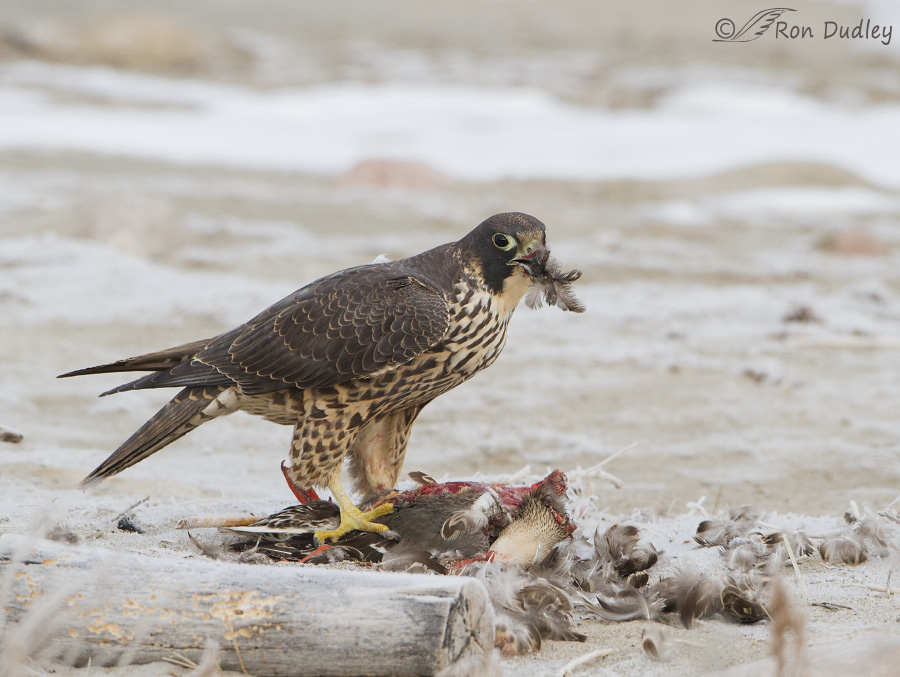
1/320, f/5.6, ISO 640, Canon 7D, Canon EF 500mm f/4L IS USM, not baited, set up or called in
The duck feathers were really flying while the falcon was plucking its prey but the feathers in the air were usually soft because of shutter speed and DOF issues. Gobs of feathers would stick to its bill and the Peregrine had to shake its head vigorously to dislodge them. Piles of plucked feathers surround the carcass of what I believe to be a female Northern Shoveler.
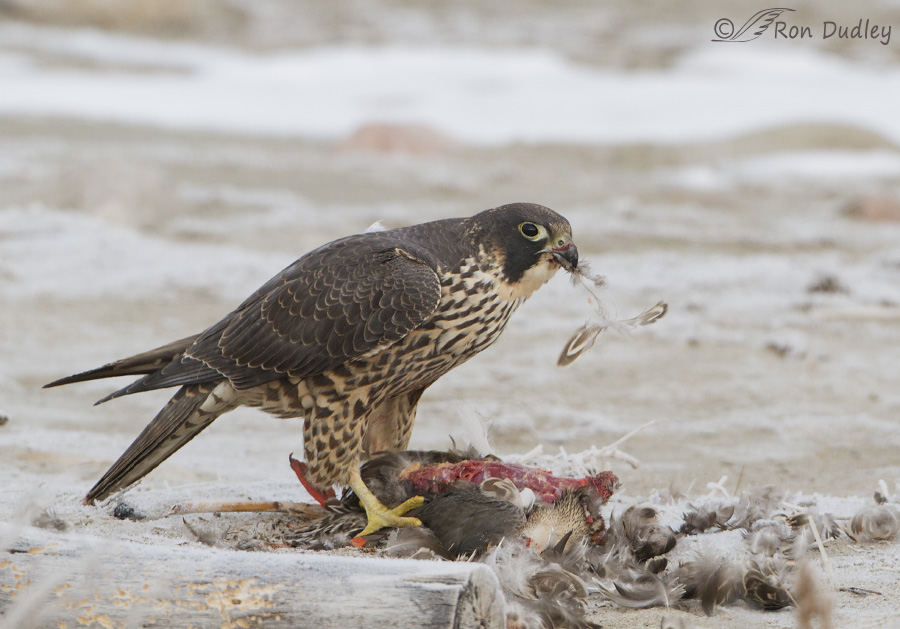
1/320, f/5.6, ISO 640, Canon 7D, Canon EF 500mm f/4L IS USM, not baited, set up or called in
I thought the gossamer appearance of these two feathers hanging from the bill was interesting.
Warning: The following two images are graphic. If such images bother you I’d suggest that you scroll no further.
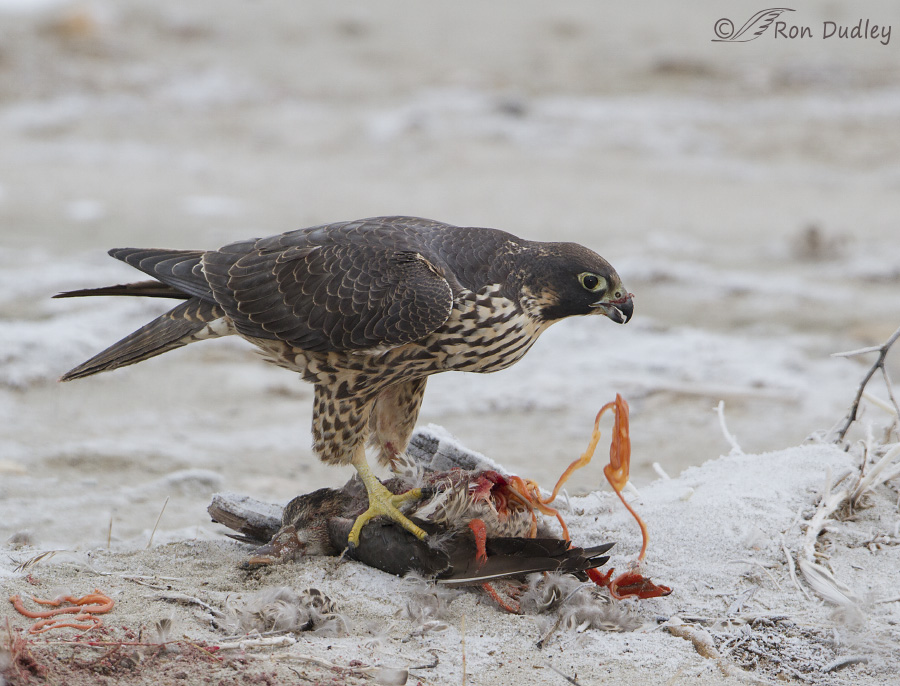
1/500, f/5.6, ISO 640, Canon 7D, Canon EF 500mm f/4L IS USM, not baited, set up or called in
Because of their difficult to digest diet (high in cellulose) many ducks have copious amounts of intestines and this finicky falcon had absolutely no interest in consuming them so it spent considerable time pulling the orange guts out of the carcass and discarding them. Eventually they littered the frozen beach around both birds.
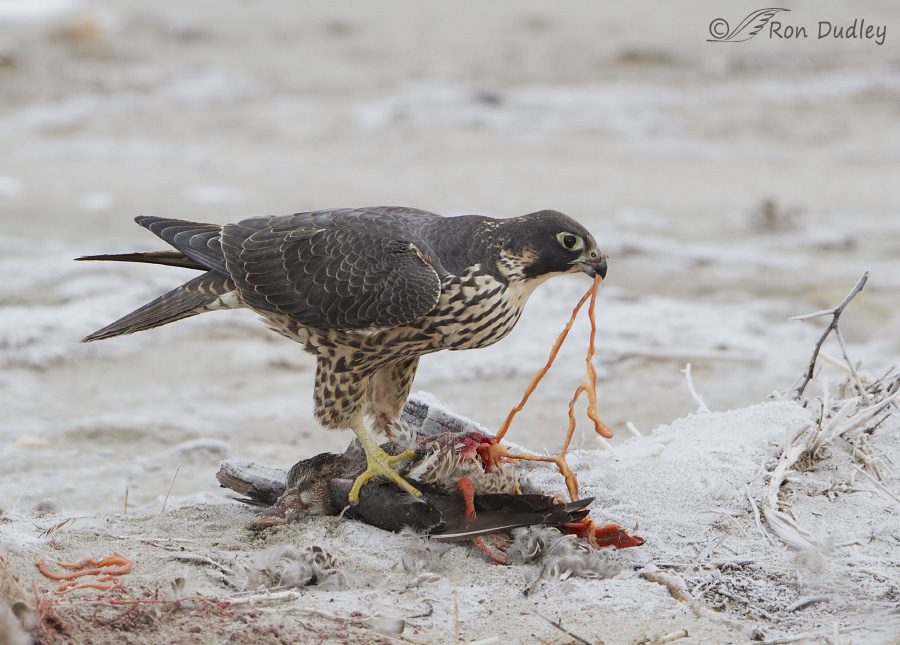
1/500, f/5.6, ISO 640, Canon 7D, Canon EF 500mm f/4L IS USM, not baited, set up or called in
In fact the falcon spent almost as much time plucking intestines as it did eating the duck. It definitely wanted them completely removed from the carcass before continuing its meal. Notice the bulging crop of the falcon.
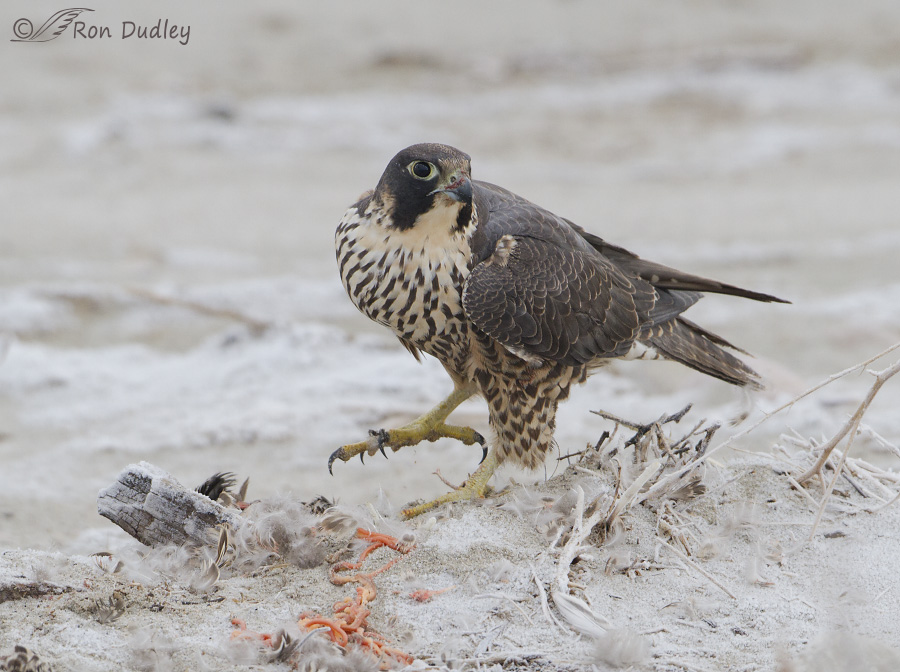
1/500, f/5.6, ISO 640, Canon 7D, Canon EF 500mm f/4L IS USM, not baited, set up or called in
Eventually the falcon dragged the duck behind this small hill – you can see parts of it below the frozen stump and the trail of intestines left behind on the path over which the duck was dragged. I include this image mostly for the good look at that intimidating right foot and talons.
I don’t know how much of the duck was actually consumed because I left the falcon to eat in peace before it became satiated. I was freezing and needed to warm up and the light was crappy anyway.
Ron


Absolutely INCREDIBLE sequence Ron!
A sensible bird. Back when I still consumed meat I discarded the awful offal too. And intestines definitely come into that category.
Yet another amazing series. ‘Power, grace, style…’
“Back when I still consumed meat I discarded the awful offal too”
Glad to hear that, EC. I’d wonder a little about you if you hadn’t…
Looks like a hatch year bird, maybe around 8 or 9 months old. Impressive, that he/she has the skill to bring down a duck at such a young age.
Here in southern california, they not quite so picky. When it comes to doves and pigeons, they will devour the whole bird including intestines and feet. Maybe something about duck intestines that is unpleasant.
Very interesting observations, Monte. Thank you very much.
Ron most of the educational birds I feed discarf the intestines and leave them for me to clean up. Nice shot of the large crop. Thanks,
Thanks for the info about your experience with them generally discarding the intestines, Diana. That certainly reinforces what I’ve seen and photographed in the field.
If you’ve ever plucked a duck, you know that they have LOTS and LOTS of feathers–it’s all about that water resistant thing along with thermal regulation. As a falcon, you don’t want to fill up on feathers and miss the main course. As for the innards, I’m always impressed with the surgical precision they USUALLY employ. The long, slender talons specific to peregrines indicate their bird-killing specialty in high-speed flight/stoops. They don’t grasp their prey until it’s already hampered–or at least until the speed of the hunt has slowed down a little bit. If they grabbed their prey at high speed, the forces of physics would result in ripping the peregrines feet/legs off, so they’ll generally rake with their talons OR punch with the whole foot and then circle around to grab the prey when things are slower. You just gotta love raptors!
I always enjoy your knowledgeable feedback about raptors, Laura. You obviously love them and I know you have a lot of experience with them through your falconry.
Thanks Ron! I’m so passionate about raptors I sometimes can’t get interested in much else–unless it’s other birds, but I’m NOT a photographer. That’s YOUR SuperPower! Your posts delight me every morning. I can’t wait to see who you’re going to bring while I’m waking with a cup of coffee. Thank you for your gifts!
Fabulous look at the habits of this amazing creature. thank you.
Thanks, Arwen.
What a wonderful series! I really like that you were able to be apparently that close to the bird. In that last shot it almost looks like the bird is demonstrating to you what will happen to you if you are not careful… especially if you try to get close to its prey. Love the facial expression in the last shot.
You’re right, Susan I was pretty close. Notice that I’d even taken off my tc.
Wonderful shots, Ron! Interesting that they don’t like the intestines – know the coyotes/magpies/ravens will eat most anything. Have seen remains from time to time and was curious as to what killed the bird and the various piles of whatever left behind. Bit gruesome, but a fact of life!
Thanks, Judy.
Wonderful series Ron!
Thank you, Len.
Great series Ron! WOW! I was fortunate back in 1996 to be at the Cape May Bird Observatory for an educational program. Birds that are netted are brought out for display as long as it fits into the one hour window of catch and release. That particular September morning they brought for viewing two Peregrine’s, an American Kestrel and a Merlin. It was quite the show! What was impressive was that the presenter spoke of seeing a Merlin once take down a Great Blue Heron! Yikes!
Holy moly, Nancy – a merlin take down a GBH! That’s almost unbelievable…
That talon is VERY IMPRESSIVE!!! I can easily see how it could nabbed something as big as a duck. I was also wondering what usually happens with the discarded intestines…in nature liitle is wasted. That bulging crop is huge…I also wonder how long a full crop like that lasts and how soon the hunt will begin again. Jerry told me the bigger the bird, the longer they can go between meals…if I understood him correctly.,,fortunate for both predator and prey…thrse are amazing captures of such a fastfling bird…on the ground, posing!!!
Believe me, Patty – these falcon leftovers are almost never wasted. Coyotes usually get them but I suppose ravens and other scavengers get their share too.
I assumed the Peregines just left the unwanted guts, but wondered what happens to them…something must eat them…a coyote? Some other bird…a Magpie, Raven? Crow? In the Winter, it’s amazing what a hungry critter will eat, things in better times they wouldn’t touch!
Sorry…I guess I was asking the question even as you were answering it…I always have too many questions, I know….
IMO there’s almost never “too many questions”, Patty. My perspective on questions is a leftover from my teaching days. After all, questions imply interest and that’s always a good thing.
Sorry I meant to ask what do these fellows do with the intestines?
They don’t do anything with them, Dick. They just leave them behind in the examples that I’ve seen. That’s a big part of the reason that coyotes prowl the causeway so often.
WOW, beautiful, great shots Ron!!
If people have looked at Peregrines haphazardly or romantically, they need to take a good hard look at the last image to see the raised killing machine!
Those talons should and do put the fear in all its prey. What a fantastic shot of why this bird is a consummate predator!!
But, I have to admit a chuckle with the image of the intestines in its beak.
Again a wonderful series!!
Dick, whenever I see the feet of a large falcon I shudder to think of the devastation they can inflict, especially at “falcon speeds”. I saw (and photographed) it happen once – a Prairie Falcon striking a duck on the water and the results were VERY impressive.